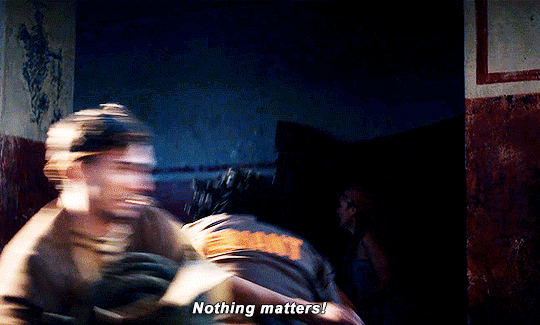Text
Rant time: fuck it I don't care about having scraps of representation from mythology, I looked at Shikhandi for a sec and went, "ooo cool rep in Hindu mythology", but fuck it maybe I DON'T want to reclaim someone who was reincarnated as a trans man because his previous female self got fucked over by a patriarch and wanted vengeance. Reading Devdutt Pattanaik's article on this just tells me, "Shikhandi ended up being born as a man out of vengeance, and his gender is up for debate by everyone else." In Devdutt Pattanaik's account, Krishna's opinion on Shikhandi's gender seems to matter the most, we're not even going to LISTEN to Shikhandi. I'm not reclaiming that, I'd rather look upto real life transmascs and turn my transness into a gift, a source of joy, because I CAN.
7 notes
·
View notes
Text
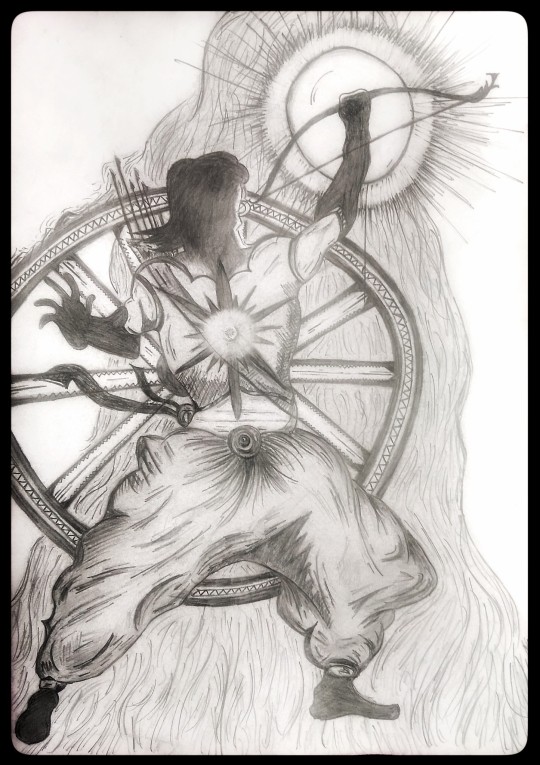
Karna
.
Arguably one of the finest characters ever written, especially when it comes to an epic or mythology. A lot has been written and talked about Karna's character since ages. From its socio-political aspects, which provide strong insights about the social fabric and culture of our society as well as history, to it's psychological aspects, making it a character well respected by both, the characters of the epic Mahabharata itself (irrespective of the side they were in the battle), as well as every reader / person knowing about Mahabharata.
While these dynamics or aspects are most prominent and obvious making them pretty well known as well as well discussed; As they should be to serve their respective purpose of questioning the concepts of system, justice, equality and morals; there are deeper, philosophical interpretations of the character which are mostly subjective.
Karna who is "Son of the Sun" represents "The Sun eclipsed by the society". Sun represents many things depending upon the various theories and subjects, including the true soul of an individual, true or maximum or highest form potential, Leader, Ego, Self / Personality etc.
Karna being the son of the Sun, in a way represents that part(s) / dynamics / qualities or aspects of the Sun (Put here any philosophical / mythological interpretation of the Sun) which are as much capable, deserving and potent as the remaining self (of the same individual) but never get a chance to show themselves.
An alter ego version of the individual trapped by the forced limitations, boundaries and structure of the society, holding as much power and potential, as the true individual itself but only to suffer, waiting for one single chance to express or prove itself.
Or in other words, it is the sum of all the possibilities, opportunities, aspects and probabilities, one loses throughout the life, not because he/she was incapable or had no potential to achieve it, but one loses it because he/she was fed by the imaginary boundaries and limitations forced by society in the name of false or outdated morals, concepts and systems.
18 notes
·
View notes
Text
Mortal combat between father and son
Here's a myth. It's a common myth, but not a very well known one.
A woman has a sexual liaison with a man who is travelling far from home, or he leaves her for some other reason. There may be a powerful sorceress involved too, or they may be the same woman. The man departs, but she keeps a token.
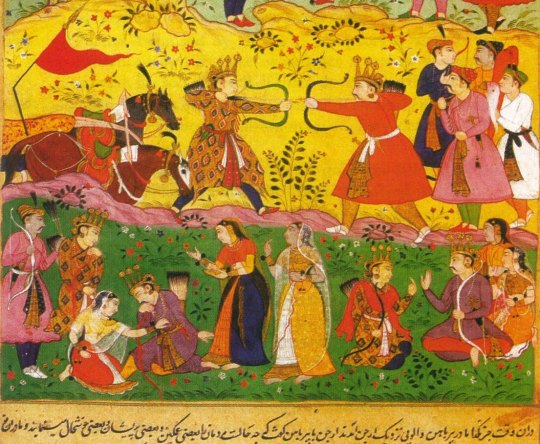
Combat between Arjuna and his son Babhruvahana. (Detail from the Birla manuscript of the Razmnama, a Persian version of the Mahabharata, 1605)
Unknown to the man, she gives birth to a son. The son grows up miraculously quickly. He asks his mother about his father, and she passes the token on to him.
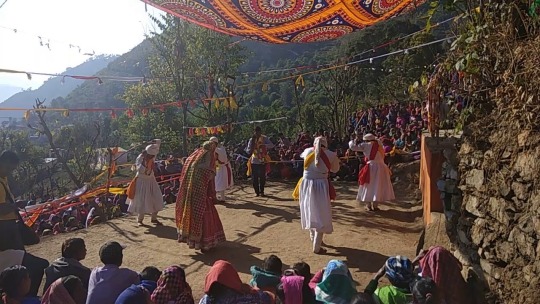
A pāṇḍav līlā dance in Garhwal, northern India, enacting the Rhinoceros Tale, in which Arjuna unwittingly kills his son Nagarjuna.
Either the son goes in search of his father, or the father returns one day. The father and son end up fighting, usually in an error of mistaken identity. One of them is mortally wounded. As he lies dying, the token is finally recognised, and they belatedly realise each other's identity.

Faroese chain dance, in which the entire community sings ballads or kvæði. One such ballad is Sniolvs kvæði, in which Hildibrandur unwittingly kills his son Grímur.
But the sorceress knows of a magic that will save the dying one, or even bring him back to life after he's dead. Fetching it may involve a quest. Once the magic is fetched, it may work -- or it may be too late.

The Cossack hero Ilya of Murom fights his son Sokolnichek, as depicted in the 1956 Soviet film Ilya Muromets. In the film, Sokolnichek ends up joining his father's side; in some 19th century byliny, Ilya kills him.
This legend appears in both ancient and modern India, ancient Greece, mediaeval Ireland, mediaeval Persia, Germanic poetry, Norse saga, 19th century Russian byliny, and 18th-19th century ballads from the Faroe Islands. So it seems to be an Indo-European thing.
I'm a Hellenist, so I know the Greek variants best. Many elements don't appear in the fragments of Eugammon's Telegony, but they're there in later Greek sources: the resurrection magic is in Theon's commentary on Lycophron, the recognition token is in Dictys of Crete and in Sophocles' lost play Euryalos.
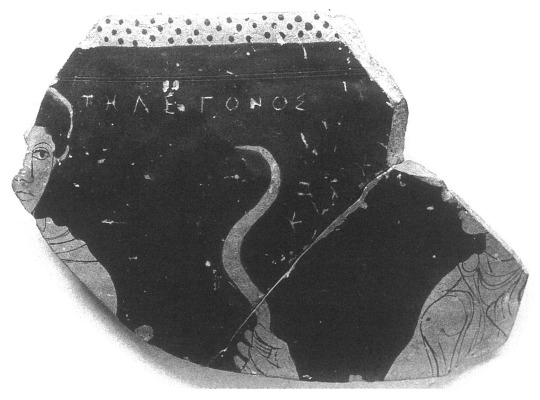
The only surviving ancient Greek image of Telegonus. Circe, right, is handing a bow to her son. (Budapest, Museum of Fine Arts 50.101; from Acrae, Sicily, ca. 400 BCE)
But the others have their fascination too. A special weapon appears in some -- Cú Chulainn's gáe bolga, Hildibrandur's sword, Odysseus' bow, Telegonus' spear. Some versions explore variations on who kills who. Ilya of Murom and Sokolnichek, and Cú Chullainn and Connla, take turns beating each other; Odysseus has three turns with three sons, with three different outcomes. The Hildebrandslied is ambiguous because its ending is missing. The relationship between the women is fascinating too: Chitrangada and the Nagini Ulupi, Circe and Penelope, Aífe and Scáthach. Some of them are just quirky: in the Jaimini-Āśvamedha (ca. 10th century), Babhruvahana beheads his father Arjuna, and when he comes back with the magic stone to revive him, the head has gone missing; so Krishna himself pops up to bring Arjuna to life. (This version also appears in the 1977 film Babhruvahana, in Kannada, starring the great Rajkumar as both Arjuna and Babhruvahana; in the film, they have a sing-off before fighting!)
It's tough to pull this material together, especially when some of the sources aren't available in a modern translation. There's no unabridged, literal translation of the Persian Shah-nameh; only parts of the Mahabharata are available in a modern translation. There's no translation at all of the Faroese Sniolvs kvæði, or of two of the Russian byliny that tell the story of Ilya and Sokolnichek. But I can still post about it on Tumblr!
82 notes
·
View notes
Text
A very common misconception I've seen going in and outside the community is that ancient India was pro homosexuality. Some even go as far as saying medieval India celebrated homosexuality and the entire concept of homophobia was introduced by the British.
While it indeed is true that ancient India recognised homosexuality, it's important to understand that's all they did, recognise it. They certainly weren't pro gays.
Now a very common argument I've seen people putting forward is the erotic sculptures in Khajurao where they portray gay sexual imagery.
This seems to imply homosexuality was acceptable in India at that time. However, the truth couldn't be further from this.
The reason behind this is the Chandela dynasty, who had the temple made followed tantra. Tantric principles believe in sex being a spiritual equilibrium of male and female forces, a way to meet god.
Most sorces state the sculptures were there to channel the holy energy born from the unification of male and female auras, so then why sculpt gay men and women? (There are even sculptures which portary bestiality, this raises some serious questions but we'll come back to that later) Was it there as a sign of acceptance of queer people or merely for fetishization? The former seems unlikely given the rest of Ancient Indian history with homosexuality.
Enter caste. It was easy for upper caste privileged Brahmin men to get away with living any way they wanted. They could have sex with anybody they pleased including with or without consent without facing any consequences.
They were the once with influence and could easily get their way around laws which mind you never for once were LGBTQ friendly.
According to the Arthashastra Brahmin men could clean themselves of their sin if they had sex with another man by taking a holy bath and keeping a fast, while Brahmin non virgin women had to pay a small fine. While I can't find any source talking about why the emphasis on non virgin women, it really isn't hard to guess. There are several sources pointed to the fact that the other castes, the ones considered to be lower by Brahmins were punished heavily for indulging in homosexuality. More than one source talks about public whippings, some even death.
It is important to understand that a few ancient texts about some upper caste man having a secret gay relationship is not what being pro homosexuality means.
Another example would be the Ramayana which has stories about queer Rakshasa women, this is a clear demonization of homosexuality.
Mahabharata too talks about queer characters, the biggest example would be Shikhandi. Remember how Bhisma refused to kill him because he still considered her a woman? I really don't see how that is queer affirmative. And even without that all through the text Shikhandi has been constantly discriminated against because of him being trans.
Best summarised by Devdutt Pattanaik homosexuality in Hindu literature though not mainstream was acknowledged but not approved of.
It is important to understand that ancient Indian society was also a society. It was disjointed and divided among people with different opinions. Some texts disapprove of being queer strictly, while some others barely acknowledge it. Even back then like now, queer issues were not common knowledge and certainly not highlighted.
47 notes
·
View notes
Photo
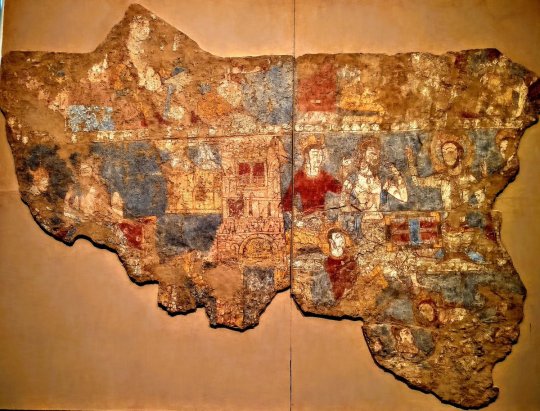
The Dice Game, scene from the Mahabharata found on a mural in at Penjikent, Tajikistan
76 notes
·
View notes
Text
@syabudakbarubelajar, thank you for the mention on that post. However, there are a number of things that are incorrect about it, and in one case, something I consider actively harmful regardless of whether it was intended that way or not.
Arjuna does not ‘choose’ to disguise himself as a ‘genderless dance instructor’. He very much still considered himself male, and to go so far as call eunuchs as a whole in the Mahabharat ‘genderless’ is both rude and a slap in the face. Eunuchs were still considered male, they were just considered ‘lesser’ men due to their castration - be it of the penis or the testes. As they no longer possessed these genitalia, these ‘defining’ features of manhood, eunuchs were made to dress in women’s clothes. It was, sadly, a mockery in some cases and humiliation in others. That is not to say that some who identified as the third gender, hijra, didn’t do this possibly of their own accord if they had the means and ability, but it would have been a great risk to their well-being depending on their circumstances. But that is beside the point.
The fact of the matter is, Arjuna being made to spend a year as either a eunuch or a woman (in all that entails), was absolutely ‘a gender thing’. It was his punishment for, however unintentionally, offending the aspara Urvasi when she approached him with amorous intent during his stay in Indraloka, the heavenly realm of his father, King of the Gods.
The asparas perform their dances for the entertainment of Indra’s divine court, and Urvasi noticed Arjuna’s attention lingering on her during one such performance. Believing that he found her desirable, and being open to the idea of having sex with him herself, Urvasi later introduced herself to Arjuna in his room. However, Arjuna turned down her advances and informed her that he considered her beautiful - but as a mother figure. In some tales Urvasi dallied with Puruva, an ancestor of the Kuru dynasty which Arjuna is descended from, and because of that association he didn’t wish to bed her. Urvasi takes offense at this, rightly pointing out that asparas cannot be mothers, but Arjuna nonetheless disregards her statement and proceeds to attend her as a motherly figure.
Insulted, Urvasi curses him - to spend all the years of his life as a eunuch, or a woman depending on the version you learn growing up, because it does differ across regions. But the curse is absolute: Arjuna will have no choice but to be forcibly emasculated and lose the privileges he’s known all his life as one born as a man. To be made to understand the indignity and pain that comes from womanhood, of being ‘other’.
Indra, and in some versions, other gods, intervene and negotiate for Urvasi to restrain her temper. For her curse to be lessened down to a single year instead. So she gives Arjuna the choice: to live the rest of his life as a eunuch (or a woman, in which case he is physically transformed by force into a woman), or to live as either for one year only. Indra encourages Arjuna to pick the year, as it will come in handy in providing an impenetrable disguise for the last year of the Pandavas’ exile, and so Arjuna follows his father’s wish.
Time flows differently in Indraloka, and down on the earth, Arjuna’s mortal family has already lived out 12 years of exile. When Arjuna is told he must return to the mortal world, the curse takes effect. Without his choice, what he cares for it, and it alienates him from the rest of his family.
Make no mistake, his brothers, mother, and wife Draupadi still love him - but they are shocked and uncertain of how to deal with the change. Arjuna is no longer the person he has long grown comfortable as - he is a stranger in his own skin, he can no longer stand up for himself or his family when they are in danger (because a eunuch has no place, no voice, and a woman would be beaten nearly to death if not worse if she raised her voice to a man), and he must for an entire year keep to the edges of the Virata kingdom, protected only by the thinnest of authority granted to him for being accepted as Princess Uttara’s dance instructor and undergoing a humiliating, invasive bodily search before the King of Virata and his advisors to prove beyond a shadow of a doubt that ‘Brihannala/Vrihannala’ was what ‘she’ claimed.
Arjuna’s brothers didn’t disguise themselves as women because they didn’t have to. Yudhisthira, Bhima, Nakula and Sahadeva had 12 years to think about their disguises, because they, along with Draupadi and Kunti, had to stay in the mortal world for the duration of their exile from Indraprastha. Arjuna was the only one to be allowed into the realm of the gods, a place he had no right being in because no mortal was ever supposed to set foot in Indraloka, but Indra made an exception so that he could teach Arjuna how to use the celestial weapons of the gods for the upcoming Kurukshetra War.
The only other instance of Arjuna being turned into a woman (literally, from the top of his head to the bottoms of his feet) is set during the Padma Purana, which took place years before Arjuna was cursed by Urvasi.
Now in the context of Fate as a whole, Arjuna’s curse from Urvasi would absolutely still be ‘a gender thing’. That is the whole point of the curse. It’s stripping Arjuna of his overconfidence and pride, making him see life through the eyes of someone who, culturally, tends to be pushed to the outskirts of society. It is humbling him, and teaching him the pains that a different gender/sex encounters daily. (It is implied in the versions where Arjuna physically becomes a woman, that Urvasi particularly meant for him to experience the discomfort and indignity of a menstrual cycle - of his joints swelling, getting headaches from blood loss, of being dirty because of one’s own blood - which is often viewed/depicted as a source of shame for the woman involved, though she herself did nothing wrong.)
Now would Arjuna think back on this time fondly? It is, in my opinion, doubtful. He would in all likelihood have negative associations from that period of his life. He has to watch as his wife, Draupadi, is very nearly sexually assaulted frequently enough during their time in Virata that Bhima, disguised as one of the palace cooks, physically beats Draupadi’s assailant almost to death and rips him apart with his bare hands; while Arjuna himself can do nothing but watch. Because if Arjuna - if Brihannala - had done anything, it would have cost the Pandavas everything and lengthened their exile by another 12 years.
Arjuna has to watch as Uttara, his pupil, who is 14-15 when he first meets her, is objectified by men old enough to be her father and then some and see her be accosted/propositioned, because her status as the Princess of Virata does not afford her protection - it makes her an even bigger target. And he cannot do anything. Because he is not ‘Arjuna’, now, he cannot be ‘Arjuna’. Arjuna was a kshatriya, a trained warrior of the upper caste, he could wield weapons and challenge whoever offended him and not be ridiculed or reviled for it. In his disguise, as ‘Brihannala’, he can do nothing but seethe, and perhaps try and steal Uttara away before the absolute worst can happen.
Would he miss the songs and the dances, of teaching a student something entirely new and unrelated to battle? Probably, seeing as Arjuna makes it very clear that he thinks of Uttara as his daughter, and he loves her as a paternal figure might. But he would probably flash back to the unpleasant times even more so, and that might be enough to rob him of whatever joy teaching another brought. That is, at least, my belief on the matter.
For those curious, my sources mainly come from the Mahabharata as retold by William Buck, The Illustrated Mahabharata by DK as published by Penguin Random House, and The Ramayana and Mahabharata translated by Romesh C. Dutt.
Free to read sources as provided by @lunarimpact: PDF files of all 12 books, an ebook available at no cost, audio books for those who would like to listen to it in Sanskrit.
Quora has good discussion about the Arjuna/Brihannala section of the Mahabharata as well. This site also offers its own take as well. And for anyone who may be curious about LGBT themes in Hindu texts, this article had some nice examples.
But please, do not take Fate’s depiction of Arjuna as the end-all, be-all. Because it isn’t. There’s a lot that isn’t brought up, or is outright erased, and it’s honestly exhausting seeing a character as complicated and nuanced as Arjuna get watered down to a few spare traits and a resting bitch face. The same goes for Karna, Kama,Rama, Parvati, Ashwatthama, Ganesha and Lakshmibai - who was a real life woman. Please, do your research. It’s worth it, in the end.
112 notes
·
View notes
Note
i have a BIG mock test next monday, it’ll cover science and math and theres so much to memorize!!! also, i enjoy reviewing for math and solve equations rather than study biology and chemistry but i know i need to focus on it more... tips on memorizing so much and understanding concepts?
Hey :-) Here are some tips for more effective studying:
make a short to-do list - write down 3 things you’d like to do in your studying time. Do the most important or the one that will take the longest first.
schedule and plan your time - try to work in blocks of about 25-30 minutes with a couple of minutes break in between. Your attention span is generally around that amount of time so if you can focus for the entire time, you’re able to get a lot more done. Use apps like Forest or Pomodoro to monitor your time!
put away any distractions - leave your phone in another room and behind you. Forget it is there and concentrate on what you’ve got to do. Extensions for your browser like RescueTime can help you avoid going on websites that distract you.
figure out what study methods work for you - everyone is different and has different methods of memorise, learning and understanding. Some people know they learn best with visually or listening. If you don’t know, take this quiz to try and identify your learning type. My study method is as follow: read my notes/textbooks and type up notes, print them and highlight/annotate them, create mindmaps/flashcards for things I need to definitely remember, write practice essays (either full essays or just bullet points), do practice papers and read sample answers.
don’t be a passive studier - it is easy to kind of passively read your notes or do the easy parts of the course because you feel like you’re studying but really you’re just doing something that isn’t using much brain power. As you revise things that you already remember, keep it brief, don’t spend a load of time on it. Spend time on the harder things. That way you won’t be freaking out if you’re asked something that you don’t understand because you couldn’t be bothered to learn it.
tailor your notes/workings to the subject - using the same method for every subject sometimes just instant effective, especially when some subjects are content heavy and others are concept based! Figure out the most practical way to approach a subject and make sure you’re making relevant notes to the topics. (For example in my content heavy subjects I would spend time finding evidence for essay questions where I needed to make a judgement rather than copying down descriptions about the topic. In those subjects I was asked to “evaluate/assess/examine” and not explain so I needed to find extra resources to actually make a judgement and not use know the textbook word for word.
use a colour code - I find this such a useful tool and I’d recommend it to everyone. It doesn’t have to be super detailed or complicated but just enough to easily pull out the more important information.
create a format/layout for your notes - I use the outline method because I find it the easiest and most effective for me. Here is a brief explanation of mine.
make study notes/revision notes throughout the semester - as you finish a topic, make some type of study notes. This could be flashcards, proper notes, a mind map or summary powerpoint! With textbooks, summarise each chapter on a flashcard or post-it note once you’ve read it. Then when you come back to review at the end, you’ve got everything in your own terms anyway.
stay positive - knowing you have a lot to study is daunting, there is no doubt about it. Try to think that you’re doing something about it and not leaving it until the last minute. You’re better off studying than failing. I’d rather study than regret not revising whilst I had a chance.
Here are some tips for memorisation:
read and summarise - read the passage over. Highlight or underline key words and only key words! Summarise in your own words what you’ve read. Try to make it simpler and more to the point.
listen to audio - either place your notes into google translate or if you have a mac, select the text and click “add as spoken track to itunes”. That way you’ll get a file just talking about your notes which you can add to your phone. I did this with an essay two years ago and still remember it haha!
make sure your studying in an active and meaningful way - just passively studying isn’t going to put the information in your brain. You need to find ways to engage your brain. This could be using different study methods such as mind maps, study groups or flash cards!
handwrite your notes - by writing things out you’re giving your brain more time to process the information and therefore it is being more absorbed.
set up a study schedule over time rather than trying to cram - you’re better off doing an hour of study of a topic over a few days or weeks compared to trying to memorise everything in 4 hours.
talk about it to someone - ask a family member or friend to test your knowledge. Try to explain the concept to them without your notes. If you can manage, awesome! If not, you’ll be able to see where your knowledge gaps are.
use mnemonic devices - this could be making a story, an acronym, or rhymes!
get some sleep - sleep is an easy way to boost your remember. A lot of people recommend reviewing notes or flashcards before bed!
use a colour code - I love colour coding my notes! It helps me visualise my notes when I need to remember things!
follow the curve of forgetting - You can’t be expected to remember every single thing from a class. Here is a graphic on the curve of forgetting. As you can see with the blue line, most of what you learn is forgotten if you don’t review it. But what the other lines show is how is can be retained if you review consistently. Make an effort to review your notes after class, after a day, after a week, and after a month. Here is a printable you can use :-)
In this printable pack, I have a few pages that might help! xx
274 notes
·
View notes
Text
How To Study Vocabulary
Since I ALWAYS struggled with learning vocabulary, I went to the library and borrowed every book about language learning that I could find! I will list different methods down below. I hope they‘re as helpful for you as they are for me! Also, this will be kind of a long post, so I apologize.
Firstly, it‘s important to acknowledge that there are different learning-types, and we all learn differently, so there‘s no guarantee that these will work for you!
Repetition of Vocabulary
1. after a couple of hours
2. after a day
3. after a week
4. after one month
5. after 3-4 months
It‘s also important to remember that you should only study a word/phrase until you know it. Everything else will be a waste of time. You should still repeat the words like I said above.
Different methods:
-Mind mapping
-Arrange the words into groups
-Structure things (e.g. vegetables: beans, carrots, tomatoes)
-Order things after similarities/differences
-Gradations (e.g. temperatures, months, time etc)
-Learn with pictures
-Step by step (e.g. ordering food in a restaurant)
It is important that you change things up and not study everything the same way every time! Your brain needs changes to understand things or you won’t be able to use the words in an actual conversation.
Other things you can do:
-Watch Videos in your target language
-Listen to music
-Record yourself saying the vocabulary and listen to it while you study
-Read read read, honestly just try to read as much in your target language as possible
-Try to think in your target language. Describe your surroundings to yourself, count things
-learn about the things you‘re interested in. If you’re interested in fantasy, learn those fantasy words fam
- never learn more than 30-40 words a day. Recommend would be 8-10 so you actually remember them -> Quality not Quantity!
-consistency is key
-some days it just won’t work and that‘s okay. Just try again tomorrow
-put random words/sheets with words on places where you will see them, e.g the bathroom mirror or the fridge or the inside of the door. You will read them all the time and will probably remember them way easier because of this.
I hope this was at least kind of helpful. I think the most important part for me to realize was that your brain needs changes in order to learn new things. If you just read one word 10 times you won’t remember it.
Say it, write it down, listen to it and write it down in a different context again. Read the words to your Axolotl.
Context is so so so important and will help you to remember words way easier.
Also remember to drink lotsa water because water is good. Also learn the word for water in your target language!
521 notes
·
View notes
Text

How to use your public transport time
A lot of students have to travel a long time to get to school, and that time adds up. I spend 3 hours every day on trains, and I’ve learned some things over the last few weeks!
Here’s some tips:
Do your homework.
Trains or busses don’t give you a lot of space, so choose what to take out. Since writing can be difficult without a proper surface, I prefer working on reading assignments or using my laptop.
Keep what you need close together and easily accessible, so you can get everything quickly. It helps to prepare beforehand (e.g. while waiting for the train).
Do further reading.
You’ve probably got a ton of extra reading recommended by your teachers, and let’s be real, nobody has time to work through everything. But if you’re stuck there anyway, you might as well take out your laptop or a book and read for a bit.
You don’t have to focus as much because you’re not doing an assignment, so I recommend it for the way home after lectures.
Organise.
Take out your planner or journal and plan your day, update schedules, or check what you already got done.
If you’ve got WiFi, check your emails! Can’t do that often enough anyway :)
Take a break.
This my sound like the opposite of what I’ve been saying, but hear me out.
Things are stressful. And while working while on your daily commute seems useful, sometimes you need a break between school and studying.
So take that time and consciously make an effort to breathe, close your eyes for a minute, listen to your favourite music, and don’t think about what you have to do.
It’s okay to not use every minute to work, because taking some time for yourself can be much more important.
Things to keep in mind (and your bag):
As mentioned before: prepare what you need to get out.
Have some pens ready in an outer part of your bag, including one or two highlighters, a regular pen and a pencil.
Headphones. Seems like a given, but I’ve left the house without them and deeply regretted it. Not necessarily for music, but just filtering out noise can help.
If you’re going for the break option, some food to replace a small meal can save cooking time at home. Since I’m at uni well into the evening, I take a small container with me to eat as dinner on my way home.
A lot of time gets lost while switching and waiting. It’s difficult to really work while standing around on a platform, so I recommend to read in a book or revise with flashcards instead of loose papers.
Perks:
As someone with anxiety, I find getting started on tasks often very difficult. The train is a low-stakes environment, because if I can’t deal with something right then, I just shove it back into my bag and listen to some tunes.
It helps me to think “I’ll just do a little right now” instead of “I have to get this done right now”.
You can use the time. It’s way less frustrating to think of 3 hours of possible working than 3 wasted hours.
I hope y’all found some of this helpful :)
A long commute can be annoying, but it can relieve your workload at home. May all your trains and busses be on time and your focus excellent ☀️
547 notes
·
View notes
Text
MY study tips!!!

I think it’s time to share with you what I actually do when I study. Here’s a list (non-exhaustive) of the main tools I use before an exam. Enjoy!
I read my notes consciously, then I hide them and try to write down everything I remember. Then I’ll take my notes again, and look for what’s missing. Not only it permits me to see what I still don’t know, but it also consolidates what I already know. This one really works if you have to learn pathways, key concepts, etc. Re-write as it comes to your mind, make a mind-map, use arrows, etc.
Once I identified what I don’t know, I’ll just put a mark on my notes, so I know that this specific part needs to be more reviewed.
When I feel overwhelmed by all the stuff I have to review, I’ll just divide it into sections and create a study plan! 99% of the time, this makes me realize that it’s not that terrible and I can get through this! I feel much better then!
The Forest App. I don’t use it systematically but it really helps me keeping distractions away (AKA my phone) and in the end, I can have a little peek view of my study session!
Whenever I’m reading something important that I know I won’t automatically remember, I write it down on a piece of paper. Indeed, I always use a bloc-notes when studying, so I just write down important points. By doing this, I become more active when learning and actually remember better! And sometimes I keep those pieces of paper so I can re-read them just before the exam.
I try to stick to a memorization routine. For example, if it’s the first time I read a specific topic that I have to memorize, I’ll re-read it 3 days after, then again a week after, then 10 days after, etc. This is the best way to memorize: « repetitio est mater studiorum » as my anatomy teacher says.
When reading your notes, always try to think about what could be the possible questions that are “exam askable”.
If you have any specific topics to learn about the same main subject, try to summarize each topic on only one paper sheet. It’s been proven that we tend to memorize more when we see the information only on one paper than many. For example, I’m currently preparing my microbiology exam, so I did a sheet for each virus or bacteria and put them in plastic sleeves and store them in a binder. By doing this, I’ll be able to re-read them all the days before the exam and retain the most important information!
The textbook is cool, but sometimes I’m in a rush and summaries made from previous years students will do the job. Of course, I make sure there’re no mistakes inside. And it can actually help with difficult subjects.
I only use flash cards for vocabulary (my dear Spanish!) or pharmacology. They are the PERFECT way to memorize some things by heart!
I multitask intelligently. For example, when I workout I listen to audiobooks or watch medical-related videos on youtube while walking on the treadmill
I test myself. I take online quizzes, I ask some friends or my boyfriend to interrogate me so I train my brain to see the problems differently and learn more!
STUDYGRAM
12K notes
·
View notes
Photo


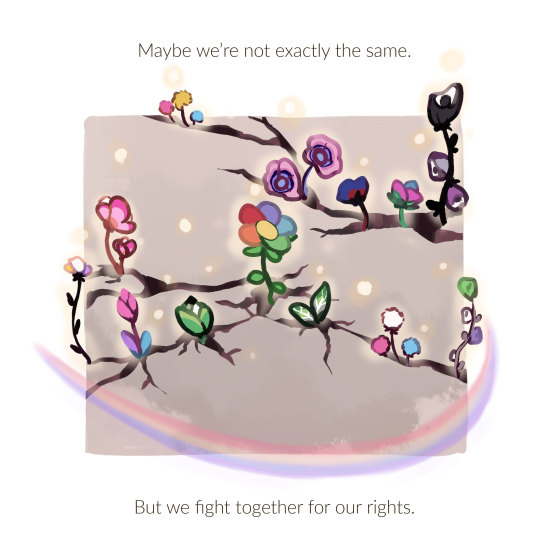

(sorry if there’s any missing reps, I’m still learning & will do better. Still, y'all matter. I respect!)
13K notes
·
View notes
Photo
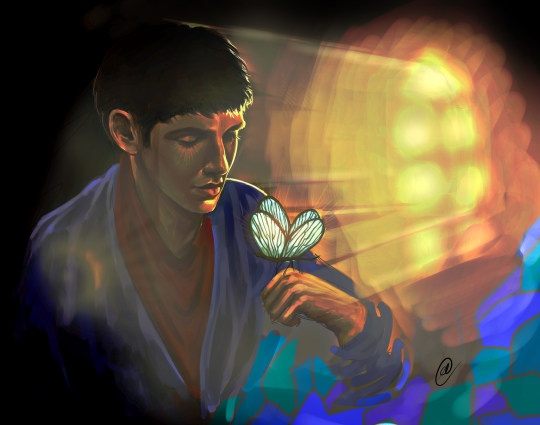
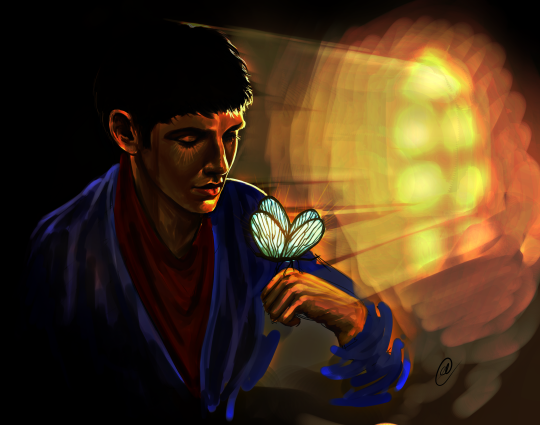

Merlin - Magic itself digital painting ~
(02/2021)
(first time actually painting merlin even though i’ve been a fan of the show for like 10+ years lol…)
3K notes
·
View notes
Conversation
Wren: The stars are beautiful tonight.
James: You know who else is beautiful?
Wren: *blushes* Who?
James: Oliver.
108 notes
·
View notes
Text
NEED A CROCHET PATTERN
Hi so I really, really, really need a crochet pattern for a mushroom bucket hat because I want to give one to my friend. It’s not urgent by any means but if someone could give me one I would be inDEBTED. Or just a good bucket hat pattern which also shows you how to attach the circle thingies. I’m pretty new to crocheting and I wanna make something nice for my friend but I can’t find any pattern and I’m not very? confident that I’d be able to make it myself. Please, more talented persons of tumblr, help me out if you can.
4 notes
·
View notes
